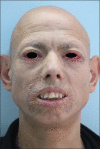Case of Olmsted Syndrome with Essential Thrombocytosis Misdiagnosed as Acrodermatitis Enteropathica
- PMID: 35068533
- PMCID: PMC8751727
- DOI: 10.4103/ijd.IJD_595_20
Case of Olmsted Syndrome with Essential Thrombocytosis Misdiagnosed as Acrodermatitis Enteropathica
Abstract
Olmsted syndrome is a rare genodermatosis. Palmoplantar keratoderma and periorificial keratodermic plaques are the most important clinical findings. Additional findings associated with a large number of systems may accompany such as teeth, nail deformities, alopecia, mental retardation, and bone-joint anomalies. Therefore, it is difficult to make a differential diagnosis from other palmoplantar keratodermas. It also needs to be differentiated from acrodermatitis enteropathica because of periorificial plaques. The absence of regression in lesions with zinc treatment excludes this disease. We present here an Olmsted syndrome case with essential thrombocytosis for the first time.
Keywords: Acrodermatitis enteropathica; Olmsted syndrome; essential thrombocytosis; mutilating keratoderma; palmoplantar keratoderma.
Copyright: © 2021 Indian Journal of Dermatology.
Conflict of interest statement
There are no conflicts of interest.
Figures





References
-
- Olmsted H. Keratodermia palmaris et plantaris congenitalis: Report of a case showing associated lesions of unusual location. Am J Dis Child. 1927;33:757–64.
-
- Duchatelet S, Pruvost S, De Veer S, Fraitag S, Nitschké P, Bole-Feysot C, et al. A new TRPV3 missense mutation in a patient with Olmsted syndrome and erythromelalgia. JAMA Dermatol. 2014;150:303–6. - PubMed
-
- Zhi YP, Liu J, Han JW, Huang YP, Gao ZQ, Yang Y, et al. Two familial cases of Olmsted-like syndrome with a G573V mutation of the TRPV3 gene. Clin Exp Dermatol. 2016;41:510–3. - PubMed
Publication types
LinkOut - more resources
Full Text Sources
